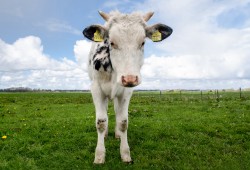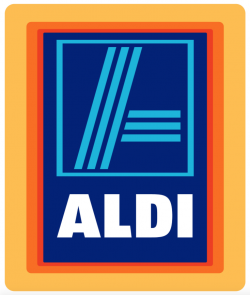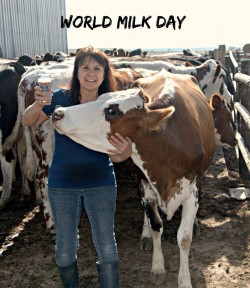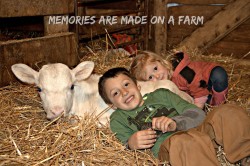News | November 1st, 2017
 FARGO – Nearly half a century has passed since North Dakota’s last milk war. In those days, when dairy farmers couldn’t make enough to live, years before North Dakota’s Milk Marketing Board began setting prices, farmers dumped milk on the streets in protest. Shots were fired, fences cut, fires set. Truck tires were slashed. Windows broken.
FARGO – Nearly half a century has passed since North Dakota’s last milk war. In those days, when dairy farmers couldn’t make enough to live, years before North Dakota’s Milk Marketing Board began setting prices, farmers dumped milk on the streets in protest. Shots were fired, fences cut, fires set. Truck tires were slashed. Windows broken.
In 1964, two National Farmers Organization members were killed in Wisconsin when a cattle-truck driver ran them over as they attempted to block access to a stockyard. In Minnesota, the governor came close to calling the National Guard for help.
Once upon a time every small town had a corner grocer, with a creamery within running distance, supplied by local cows whose mooing lulled the populace to sleep at night.
This Norman Rockwell dream ended as cities grew. Grocers began creating larger stores applying pressure on creameries to sell milk more cheaply, consequently putting many out of business. But it was the farmer who suffered most, John Weisgerber, director of the North Dakota Milk Marketing Board, said.
“If they’re going to have these milk wars, it shouldn’t come from their monies, they said in those days,” Weisgerber said. In the 1960s, North Dakota dairy farmers wanted state laws to replace federal laws, and the Milk Marketing Board was born.
Today, the milk canvas is once again shifting; tensions, once again, are running high.
In April 2016, a Buxton farmer on the online forum New AgTalk said he was too young to remember much during the milk wars of the 1960s. The unidentified man posted a picture of his father dumping milk in 1967. Another commentator reported that bigger mega-dairies are complaining about current prices, while seeing trucks of prostitutes driving by to service illegal workers.
“Some of you guys finally got my point,” another commentator said. “I also said farmers won’t band together, but if we all would, what power we could have. Funny how one oil well in the Gulf or one country says they are going to cut oil production and the next day gas is up at the pump.”
“Especially our good neighbors to the south think our supply-managed dairy and feather is socialistic, bordering on communism, but it’s okay to band together and cut production,” another commentator said.
 Milk producers and retailers are worried about giant retailers and international grocery store chains already here and poised to spread across the state. Walmart, Sam’s Clubs, and Costcos selling milk for a dollar less than local, smaller retailers. German retailer Aldi, known for slashing fluid milk prices in half or more, is preparing to open across the Red River in Dilworth, and its corporate eye looks further west, along the I-94 corridor in North Dakota.
Milk producers and retailers are worried about giant retailers and international grocery store chains already here and poised to spread across the state. Walmart, Sam’s Clubs, and Costcos selling milk for a dollar less than local, smaller retailers. German retailer Aldi, known for slashing fluid milk prices in half or more, is preparing to open across the Red River in Dilworth, and its corporate eye looks further west, along the I-94 corridor in North Dakota.
Another German grocery retail chain, Lidl, is also entering the US market, and it opened its first store in June, according to the Associated Press.
Aldi announced in July that it plans to spend $3.4 billion and open 900 new stores across the United States, with 2,500 new stores opened by 2022, according to the Associated Press. The smaller-scale retail chain would create 25,000 new jobs, primarily in the Midwest. Aldi has more than 10,000 stores worldwide. On June 15, 2016, Aldi became licensed to operate in North Dakota, and was authorized in 2014 to operate in Minnesota, according to the North Dakota Secretary of State.
If another war over milk ensues, the repercussions could be devastating for the few dairy farmers left in North Dakota. There are approximately 80 dairy farmers in the state, with 10 in Emmons County, dairy farmer Rita Mosset said.
“All milk is North Dakota milk,” Mosset said. “But now, even Costco is giving us trouble. That’s what hurts, if they want to drive to Minneapolis and buy a bunch of milk and put it in their store, that’s the hard part.”
The idea that all milk in North Dakota comes from North Dakota, isn’t entirely accurate, Weisgerber said. “It’s a matter of semantics. Is it more economical to transport from Thief River or from Bismarck where there is another plant?” Weisgerber said. “You have to look at the economics of transporting milk. It weighs 8.6 pounds a gallon.”
Milk can be brought into the state if the plant where the milk was purchased is licensed in North Dakota, Weisgerber said. Walmarts purchase all their milk from Dean Foods, so their milk comes from Bismarck or Thief River plants. Costco purchases their milk from Kemp’s Cass-Clay organization.
When and if Aldi or Lidl come to North Dakota, they would be allowed to purchase milk from outside the state as long as the plant is licensed in state.
 "I don’t know what Aldi may do, but the law in North Dakota is no one can sell below the minimum retail,” Weisgerber said. “Minnesota has a minimum markup law on the books, and they’re not enforcing it, so I guess for us, for me, and for these retail grocers that operate in Moorhead market, that’s a doggone good question: why don’t they enforce it? That’s allowing these so-called milk wars to go on.”
"I don’t know what Aldi may do, but the law in North Dakota is no one can sell below the minimum retail,” Weisgerber said. “Minnesota has a minimum markup law on the books, and they’re not enforcing it, so I guess for us, for me, and for these retail grocers that operate in Moorhead market, that’s a doggone good question: why don’t they enforce it? That’s allowing these so-called milk wars to go on.”
Typically, if a retail chain sold milk below the minimum price, a grocer in the market would file a complaint with the Milk Marketing Board, which would in turn investigate and enforce a civil penalty for violations, Weisgerber said.
The president of the North Dakota Grocers Association, John Dyste, has more than 50 years experience in the rural grocery store business. He’s seen the grocery evolution in his hometown, a decrease from three grocery stores to one. Today, there are three grocery stores in his entire county.
“There was always a new thing that came up, whether it was the Walmart coming, or the Costco coming,” Dyste said. “Through the years there’s always been the next crisis or the next concept that was going to change everything. It seems like the grocery industry has adapted and found ways to coexist with the Walmarts and Costcos in the area.
“But every time there’s a new player in town, the money gets chopped up once more.”
The North Dakota Grocers Association is a trade association under the National Grocers Association that represents retail and wholesale grocers in the food distribution industry.
On the farm
Rita Mosset and her husband, Jerome, grew up around cows, bought their farm near Linton in 1982. Their livelihood depends on being able to continue selling their milk to Land O’Lakes, hundreds of pounds every two days.
 Dairy farming, and some crop farming in the summer, takes up the Mossets’ time, basically 24 hours a day, seven days a week. They’re not a big dairy, can’t use hired hands like others nearby. Their four children grew up on the farm, and learned chores, good work ethics, Mosset said. When her children come home to visit, Mosset wants a day off, but they always end up back in the barn.
Dairy farming, and some crop farming in the summer, takes up the Mossets’ time, basically 24 hours a day, seven days a week. They’re not a big dairy, can’t use hired hands like others nearby. Their four children grew up on the farm, and learned chores, good work ethics, Mosset said. When her children come home to visit, Mosset wants a day off, but they always end up back in the barn.
As long as the Mosset family’s milk quota doesn’t shrink, they can continue to live off proceeds, but they cannot produce too much; their profits shrink with any extra milk.
“If we want to milk more cows, we have to alert them first, and see if there is room to grow,” Mosset said. She’s seen North Dakota milk prices increase in grocery stores in the past year, but her selling price dropped $10 to $12 per hundredweight.
“The milk price is so high, it’s very disappointing,” Mosset said. “They do make money on milk, because they have it priced up. They just don’t want to confess up to it.”
Mosset runs a Facebook page called RJDairy. She’s also a photographer and brings familial warmth to their life on the farm through her pictures and stories. Once in awhile, she attracts a troll.
“We farmers have nothing to do with retail prices,” RJDairy replied to a criticism on their Facebook page. “We take what we get which is 1970s prices yet. We are losing money while retail makes the money.”
“Then why are you still doing it? Suspicious?” Buck Bush, the critic, wrote.
“Milking cows because it’s a hard job, and I love my animals.”
“I don’t think it will hurt the little towns so much, because little towns don’t go into the big towns just to buy their milk.”

The milky way
Milk is a hypersensitive market, Grocers Association President Dyste said.
If the market turned to Costco or Aldi or Lidl for all their milk, the impacts would be felt from the Mosset family, to creameries, to grocery stores, to bottling companies, even feed stores and veterinarians, Milk Board Chairman Weisgerber said. Even rural retirement homes would have difficulty getting milk supplied.
“These big retailing giants, they can ruin the local business,” Weisgerber said. “It’s a sensitive topic. A local dairy farmer could take two days in a smaller truck, or a semi with 40,000 pounds of milk, delivering to small towns across the state. If he loses a grocery store there, he’s lost his volume, and yet he’s expected to service those accounts.”
Walmart ensures deliveries only to Walmarts. The same goes for Costcos, or even Aldis, and their volumes are the hot tickets for creameries: a steady and large demand.
If the Milk Marketing Board had not been approved by the state legislature in 1967, the state would have become a milk dumping ground for surplus milk, primarily from eastern dairy-producing states. For every cow milked in North Dakota, Minnesota has 30, Wisconsin 90 times as many, according to 2016 statistics from the U.S. Department of Agriculture.
“Quite simply, the milk would flow in from the east,” Weisgerber said. “And if farmers weren’t making a fair return on their milk, they would go out of business.”
The Milk Marketing Board’s legal charge is to regulate minimum wholesale and retail prices of fluid milk within the industry and establish milk-marketing areas within the state, according to the North Dakota Century Code.
In Fargo, milk ranges from Costco’s $3.05 for a gallon of two percent milk. At Family Fare, the same gallon is priced at $3.89, and at Hornbachers $4.13 for a gallon of Cass-Clay. Aldi typically sells milk with no artificial growth hormones at $2.39 a gallon.
In Minnesota, milk is typically cheaper. At Cub Foods in Minneapolis, a gallon of generic milk is $2.79. A gallon of Kemp’s Special is $3.50.
“It may be cheaper in Minnesota versus Fargo,” Weisgerber said, “but if you go to some place like Costco, you go to the Walmarts in Fargo, their milk is right down there at the minimum. What is the great draw to the grocery store? Cheap milk.”
 "I doubt that will be overall true,” Dyste said of the discrepancy between North Dakota and Minnesota milk prices. “There’s always going to be a pocket where it will be true. If you got someone that is coming in and cutting the market to make their position, then things will happen.”
"I doubt that will be overall true,” Dyste said of the discrepancy between North Dakota and Minnesota milk prices. “There’s always going to be a pocket where it will be true. If you got someone that is coming in and cutting the market to make their position, then things will happen.”
Aldis takes a loss with their milk sales, but they make up for it in other goods.
Another monkey in the milk wrench is the recent rising interest in almond milk and soymilk, products the Milk Marketing Board cannot control. Prices are regulated at the fluid milk level only, which would include liquid yoghurts, cottage cheese, and sour cream. The Milk Marketing Board has no control over butters, hard cheeses, or powders.
Bob Hendrickson of the National Farmers Organization is primarily involved with cattle, but he has noticed another new trend with convenience store milk sales.
“These gas stations are moving more milk than grocery stores,” Hendrickson said. “Husband has to pick up milk on the way home from work, and this is because of the younger generation, of course.”
“I’m seeing these larger chain gas stations out in the countryside where they’ve never been before, and that could hasten the end, there’s only so much market out there,” Dyste said.
Nationally, milk consumption is dropping
All 50 states produce milk, some more than others, and the industry has seen a consistent decline in the numbers of dairy farms, with a matched rise in cow numbers per dairy. From 2004 until 2014, the United States was the world’s third largest dairy product exporter, falling behind New Zealand and the European Union, but in 2015, US dairy exports fell by almost 30 percent.
Total fluid milk sales are down from 1975, which had national sales of more than 53 million pounds, and in 2016 a total of 49.5 million pounds. Milk sales reached their peak in the 1990s, and early 2000s, according to the United States Department of Agriculture Economic Research Service.
Products such as yoghurt and sour cream, however, have gone from a measly 425 and 350 million pounds respectively in sales in 1975, to well over four billion and 1.3 billion pounds respectively in 2016, according to the USDAERS.
Fargo public schools sell a half pint of milk for 35 cents, which doesn’t seem like a lot of money, but if you add 16 half pints to make one gallon, the cumulative selling price is $5.60.
All attempts made to contact multiple local and out-of-state grocery store managers for comment failed.
Attack on the poor
Some say – off the record – that North Dakota’s high milk prices are a secret attack on the young, the poor, and those who need nutritious milk most. People eat and drink what they can afford, sometimes being forced to make the tough choice of reducing quality for quantity, according to a 2012 United Nations report.
A difference of a dollar for a gallon of milk may not be much to most people, but for the poor it could be a deciding factor whether to buy fresh milk or something cheaper and less nutritious.
“To begin with, people start reducing the quality of the food they eat,” the United Nations report stated. “That means less fresh fruit and vegetables, less meat. They will concentrate on staples, usually grain such as wheat, maize, or rice. This impacts their intake of vitamins and protein, which can be harmful, especially when children are under two.”
When initial cuts are not enough, a family will start reducing the number of times they eat a day. Then medicine gets cut from the budget. In rural areas, especially in underdeveloped countries, a family might then sell off their chickens, or goats, or cows, which puts a few dollars in their pockets, but is disastrous for their future. They’ve lost their assets, and they’ve lost the nutrition found in eggs or milk.
When those losses are still not enough, children are pulled out of schools, and once out, they rarely go back, and the chances of pulling themselves or their families out of poverty are reduced.
You have to be rich to be poor, The Washington Post wrote in 2009. Without a car, Fargo’s poor can rarely travel to Costco and are stuck with a gas station or urban corner store, where a loaf of white bread may cost upwards of $3, with wheat bread nearly a dollar more. Two loaves of white bread at Costco cost $3.99. A gallon of milk can routinely cost over $4 at an urban store, where at Costco the price hovers a little over $3.
“One of the best ways of helping the poor avoid the worst effects of food price hikes is through so-called ‘safety nets’ – reliable systems providing food to the most vulnerable when times are hard,” the United Nations said in the report. “These include school meals programs, assistance to smallholder farmers, and nutritional support for mothers and children.”
April 18th 2024
April 18th 2024
April 18th 2024
March 21st 2024
February 15th 2024

__293px-wide.jpg)



